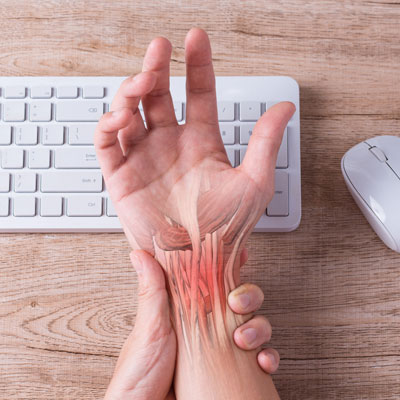Blogs
Chiropractic Care for Carpal Tunnel Syndrome: Your Comprehensive Guide to Relief

A tingling sensation in your fingers, perhaps accompanied by a dull ache in your wrist, shouldn’t be brushed off as mere fatigue from a long day of typing. For professionals like you whose work demands countless hours in front of a screen or on a keyboard, carpal tunnel syndrome (CTS) is an occupational hazard that often seems inevitable. Contrary to common belief, surgery isn’t the only solution. Chiropractic care has proven to be a valuable ally in relieving and managing CTS. This guide will walk you through the ins and outs of how chiropractic treatment can bring much-needed comfort to your hands and your workday.
Carpal Tunnel Syndrome (CTS) Treatment in Spokane, WA
At the heart of our approach to combating Carpal Tunnel Syndrome (CTS) lies the experienced team at Back In Motion P.S Chiropractic, under the leadership of Dr. Cameron Weishaar. With over 20 years of dedicated service in the chiropractic field, Dr. Weishaar is not just a practitioner but a pioneer, employing the innovative Chiropractic BioPhysics® method to ensure not just symptomatic relief but an enhancement in overall body harmony. This unique technique allows for a more holistic improvement in health outcomes, ensuring that treatment goes beyond the wrists and into the realm of total body wellness. The team, guided by Dr. Weishaar’s expertise, is committed to providing personalized care tailored to each individual’s needs, promising more than just relief but a pathway to a healthier, more vibrant life.
Understanding Carpal Tunnel Syndrome
Carpal tunnel syndrome is the result of pressure on the median nerve, which runs through the carpal tunnel – a narrow passageway in the wrist – becoming pinched and leading to discomfort and weakness in the hand. It’s characterized by symptoms such as:
- Numbness or tingling in the thumb and fingers, especially in the index and middle fingers.
- A sensation or shock-like pain traveling from the wrist up the arm.
- Weakness in the affected hand, which may contribute to dropping objects.
If not addressed, these symptoms can worsen, hindering everyday tasks and potentially causing permanent nerve damage. The cause of CTS can be multifactorial, including repetitive hand and wrist motions, improper hand position when using tools, and underlying health issues such as arthritis, diabetes, or thyroid dysfunction.
The Role of Chiropractic Care in Treating CTS
Chiropractic care is founded on the principle that the body’s structure, particularly the spine, has a significant effect on its function. By making adjustments to the spine and other parts of the musculoskeletal system, chiropractors aim to restore mobility and alleviate CTS-related symptoms. These adjustments can reduce the pressure on the median nerve, which is often a result of misaligned joints and weakened supporting structures.
Chiropractic treatment for CTS may include:
- Manipulation of the wrist, hand, and upper spine to improve function and alleviate symptoms.
- Stretching or strengthening exercises to support the adjustments and stabilize the wrist.
- Ergonomic assessments to identify and rectify work-setting factors that may contribute to CTS.
Case Studies and Testimonials
Consider the case of Kathryn, a novelist who found herself struggling to type out her stories due to worsening CTS. After several sessions of chiropractic care, Kathryn reported that her symptoms had significantly reduced, and she could type for longer periods without the debilitating pain she had experienced.
Stages of Advancement in CTS
CTS can progress through three stages, each with a different level of severity and treatment considerations.
- Stage One: Numbness and tingling are relatively mild and intermittent. It is common for patients to ignore these early signs, mistaking them for fatigue.
- Stage Two: Symptoms become more frequent and persistent, potentially disrupting sleep. Weakness and muscle atrophy are still mild.
- Stage Three: Symptoms are constant, and grip strength significantly decreases. At this stage, irreversible nerve damage is a concern.
It’s crucial to seek treatment, including chiropractic care, at the first signs of CTS to manage the condition effectively and prevent the need for more aggressive interventions.
Complementary Treatments and Lifestyle Changes
In conjunction with chiropractic adjustments, there are several additional strategies that can help manage CTS:
- Wrist Supports and Immobilization: These can alleviate symptoms by preventing unwanted bending and compression of the median nerve.
- Cold Compression Therapy: Ice packs can reduce swelling and inflammation, common culprits in CTS discomfort.
- Exercise and Physical Therapy: Strengthening exercises can improve wrist function and reduce symptoms.
- Ultrasound and Laser Therapy: These non-invasive treatments can be used to stimulate healing and improve circulation to the affected area.
Surgery for CTS: What You Need to Know
For advanced cases that don’t respond to conservative treatments, surgery may be necessary. There are two primary types of surgery used to treat CTS:
- Open Release Surgery: This traditional approach involves cutting the carpal ligament to expand the carpal tunnel and relieve pressure on the median nerve.
- Endoscopic Surgery: A more minimally invasive method, involving the use of a small camera to guide surgeons in cutting the ligament through a small incision.
Enhancing Post-Surgical Recovery with Chiropractic
Even if surgery is the chosen path, chiropractic care has a role to play in the recovery process. Each stage following surgery – acute, sub-acute, and chronic – requires different types of care, and chiropractors are skilled in tailoring their treatments to where you are in the recovery process. They can also help address any compensations or changes in your body’s mechanics as you adjust to using your hands normally again.
Preventing CTS
Prevention is always better than cure, and with CTS, it’s no different. Simple changes can make a significant difference in reducing your risk of developing CTS:
- Maintain proper posture and wrist alignment.
- Take frequent breaks to rest and stretch your hands and wrists.
- Use ergonomically designed tools and workspace setups.
- Keep good overall health to reduce the risk of underlying conditions that can lead to CTS.
Treating Carpal Tunnel Syndrome Naturally in Spokane, WA
Carpal tunnel syndrome doesn’t have to be a career-ending condition, nor does it have to jump straight to surgery as the only solution. Chiropractic care offers a holistic approach to relieving CTS by addressing not just symptoms but their root causes and contributing factors. If you’re experiencing any discomfort in your wrists or hands, reach out for a consultation with a chiropractor to explore how chiropractic treatments can help you find comfort and stay on top of your profession without letting CTS get in the way.
If you’re ready to take the next step in addressing your carpal tunnel syndrome, Back In Motion P.S Chiropractic is here to offer you personalized and effective care. Don’t wait until your symptoms worsen; book your consultation today and reclaim your comfort and mobility. Remember, the key to a successful outcome is swift and informed action. Your hands, and your livelihood, are worth it.

